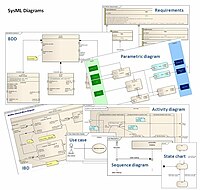SysML

SysML stands for Systems Modeling Language. It is a language used by engineers and scientists to design and model complex systems. It helps them to break down these systems into smaller parts that can be analyzed and understood more easily.
Think of it like building a Lego set. You start with a big box full of pieces of all different shapes and sizes. You could just start putting pieces together without a plan, but chances are you would quickly get lost and frustrated. Instead, you might look at the instruction manual, which shows you how to assemble the pieces step-by-step to create a finished product.
SysML is like the instruction manual for building complex systems. It provides engineers and scientists with a common language and set of tools to help them think through all the different parts of a system and how they fit together. This could be anything from a car engine to a computer network to a spacecraft.
SysML uses different symbols and diagrams to represent different aspects of a system. For example, a block diagram might show the different components of a system and how they are connected, while a state machine diagram might show how the system responds to different inputs and events.
By using SysML, engineers and scientists can work together more effectively to create and test complex systems. They can identify potential problems earlier in the design process, which can save time and money in the long run. So, even though SysML might seem complicated at first, it is really just a helpful tool to make building complex systems easier and more efficient.
Think of it like building a Lego set. You start with a big box full of pieces of all different shapes and sizes. You could just start putting pieces together without a plan, but chances are you would quickly get lost and frustrated. Instead, you might look at the instruction manual, which shows you how to assemble the pieces step-by-step to create a finished product.
SysML is like the instruction manual for building complex systems. It provides engineers and scientists with a common language and set of tools to help them think through all the different parts of a system and how they fit together. This could be anything from a car engine to a computer network to a spacecraft.
SysML uses different symbols and diagrams to represent different aspects of a system. For example, a block diagram might show the different components of a system and how they are connected, while a state machine diagram might show how the system responds to different inputs and events.
By using SysML, engineers and scientists can work together more effectively to create and test complex systems. They can identify potential problems earlier in the design process, which can save time and money in the long run. So, even though SysML might seem complicated at first, it is really just a helpful tool to make building complex systems easier and more efficient.
Related topics others have asked about:
